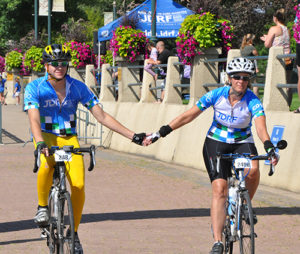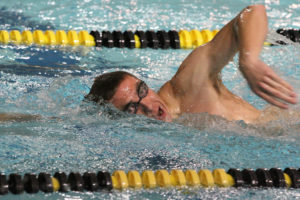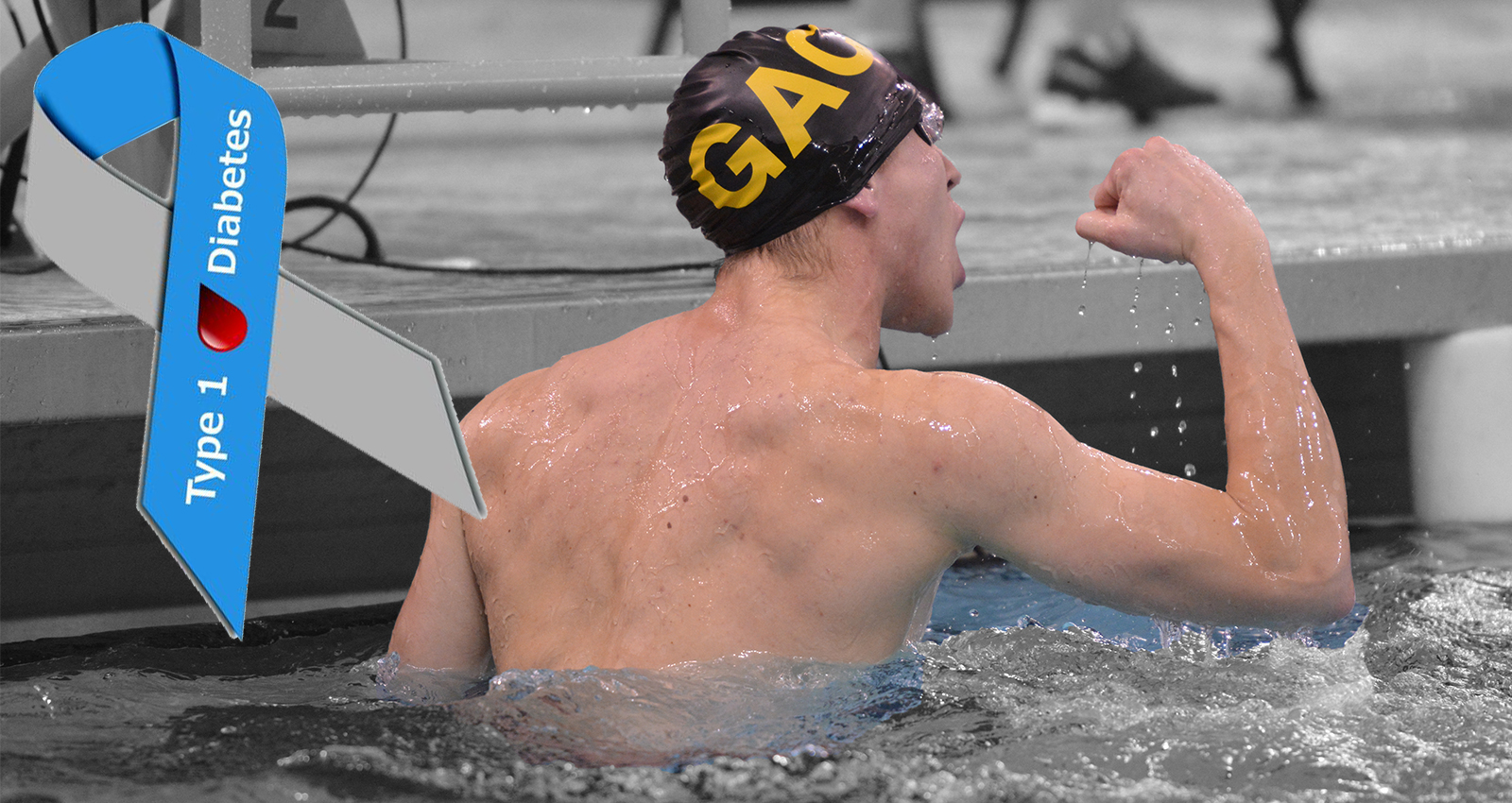Article courtesy of Matt Higgins, MIAC Assistant Executive Director
ST. PETER, Minn. – Gustavus Adolphus College senior Adam Peters (Montevideo, Minn.) looks the part of the young, healthy, vibrant student-athlete. The Gustie swimmer has enjoyed success in and out of the pool during his collegiate career, and is an extremely positive influence on his teammates.
But looks can be deceiving.
At the age of 15, Peters was in a doctor’s office, about to receive news that would change his life. However, in a remarkable display of maturity for someone his age, he decided that news would never define him, never limit him, or never alter his goals in life.
Peters was in the middle of his high school swim season in Montevideo, Minn., and noticed his times weren’t getting better – which was odd for a young athletes putting in the type of work he did. He was losing weight rapidly – about 12 pounds in a short period of time – and was drinking gallons of water a day just to stay hydrated. His parents scheduled a trip to the hospital and subsequent tests revealed what his mother suspected and feared – Peters was diagnosed with Type 1 Diabetes.
“A month prior to my diagnosis, one of my mom’s best friend’s kids was diagnosed with Type 1,” Peters said. “She learned all the symptoms and signs so when I came home and told her I was always thirsty, tired, dragging, she put it together with the weight loss and knew exactly what was going on with me. I could tell she was scared, I didn’t know yet what was going on.”
A day after his trip to the hospital, the results of his blood work came in. Peters’ dad picked him up from school in the afternoon, and on the drive, his father broke down sharing news no parent ever wants to have to break to their child … that something is wrong with them.
“He’s the one who picked me up because [my parents] though he could hold it together,” Peters said, “but even he couldn’t.”
When they arrived at the hospital, Peters officially received his diagnosis and an influx of information about Type 1 Diabetes. Previously known as Juveile Diabetes, Type 1 is typically diagnosed in children, and affects only five percent of diabetics. According to diabetes.org, the disease prevents the body from producing insulin, which is a hormone the body needs to get glucose from the bloodstream to the cells of the body. With Type 1, the patient needs to balance insulin doses – typically in the form of a self-administered shot – with the food they eat and the activities they perform. They need to constantly monitor their blood sugar, and ensure their glucose levels don’t get too high or low.
After learning of his affliction and how it would affect him, Peters was asked what he thought of it all. “My response was, ‘Well, it’s not like I have a choice,’” he said. “I could either take care of myself, be healthy and live my life to the fullest, or I could let myself go, not take care of myself and suffer physical repercussions down the road. I think I made the right choice. That was my mindset – I took the bull by the horns and am just riding it out.”
In addition to his positive mindset and approach to his new set of circumstances, Peters also found support in the pool, at the place he would eventually swim collegiately. He had been attending swim camps at Gustavus for a few years, and when Gustie Head Coach Jon Carlson learned of Peters’ diagnosis, he encouraged him to come back to camp with some added incentive.
“We’ve had someone who’s diabetic on our team since the early 2000s,” Carlson said, “so we know a little bit about it and how it impacts athletes. After his diagnosis, he wasn’t going to come back to camp, but one of our current swimmers – Britta Nelson – was a diabetic and she’d be working the camp. I told him to come, it’d be good for him to visit with her and talk about the things she does to make swimming work.”

That visit certainly helped, not only as Peters adjusted to life as a diabetic navigating the waters of competitive swimming, but also with his outlook on how he could pay it forward. Peters saw an opportunity and a platform to help others like him. He saw a chance to make a difference and advocate for the most personal of causes.
Most of Peters’ action comes on behalf of the Juvenile Diabetes Research Foundation (JDRF), which funds Type 1 Diabetes research and aims to cure, prevent and treat the disease and its complications. Peters has been involved in a number of different ways – as an advocate, as a fundraiser, and as a role model to young kids who are looking for someone to relate to when they receive the same news he did at 15.
“He knows what it’s like to be a young person getting diabetes and how it changes your lifestyle,” Carlson said of Peters. “He just wants to help kids so they don’t have to go through as much as he did. It was hard on him and, like any family, they were all scared. He knows what kids with Type 1 Diabetes are going through, and it motivates him to work and try to raise money and be active in the JDRF.”
Between Peters and his family friend – Carson Boike, who was diagnosed just before he was – the whole Montevideo community has rallied to the cause and, together, they’ve been able to accomplish some incredible things in a short amount of time. Through the JDRF “Ride to Cure” bike ride – a 100-mile ride that raises funds diabetes research – and other fundraisers in the community of a little more than 5,000 people, Peters and company have made staggering contributions to diabetes research and awareness.
“We’ve raised around $20,000 each year,” Peters said. “I have a team – my little buddy Carson and I – and between us Type 1 Diabetes really hit the Montevideo community hard. We’ve been fundraising all sorts of money, and we get to people very year to ride for Carson and I. My best friend has ridden for six years, even this past year when I wasn’t able to. It’s become important to him and so many other people.”
But Peters’ work is about more than dollars raised. As a swimmer, he’s an outgoing, confident team leader, and those same traits serve him well as he becomes more involved with the JDRF as well. “I’m very extroverted and am willing to talk to people,” Peters said. “The JDRF noticed that and [my family] really wanted to get involved … I’ve done a lot of events through JDRF. There’s a young persons’ committee, basically made up of people in their 20s and 30s who have their own division of JDRF and I’ve done some things with them, too.”

In addition to all his positive efforts in the diabetic community, Peters has excelled in the other areas of his very busy life as well. He’s on track to graduate with a degree in Biology in May, and he’s already been accepted to Optometry School at Pacific University in Forest Grove, Ore., where he’ll enroll in the fall of 2018. He also hopes to transition from swimmer to coach so he can stay connected to the sport he loves.
He’s doing great in the pool as well – a year ago he recorded three top-12 individual finishes at the MIAC Championships (50-, 100-, 200-yard freestyles), and swam on a pair of top-five relay teams (200-yard medley and 400-yard freestyle). This season, his 200-yard freestyle relay team has the top time in the MIAC (1:27.08), his 400-free relay team is ranked third (3:17.64) and he also holds a top-20 individual time in the 50-free (22.37).
“Last year we climbed up a spot in the MIAC and this year we hope to climb up another couple of spots,” Peters said. “Our season is going superb, even though we’re all dog tired from all our training. We’re winning meets that we haven’t won in six years.
“I guess my main goal is for myself personally to excel past those times I put up at the MIAC Championships last year. My overall goal honestly is for the team to excel past where we finished last year. With me being a leader on the team, I’m hoping that they can kind of watch me like a role model – kind of like with Type 1 kids – and I’m hoping the team will continue in the direction that its headed.”
Beyond his swimming prowess, Carlson praised Peters for all the outstanding intangibles he brings to the team.
“Adam is one of the most genuine, caring, thoughtful people on our team,” Carlson said. “He’s constantly thinking – since his freshman year – how to be a better teammate and how he can help his teammates. It’s remarkable how selfless it is. He also brings a mischievousness and a real sense of fun to the pool deck. He likes to pick on me and we make each other laugh. I can’t believe he’s a senior already … I’ll miss him.”
Fortunately for Carlson, his 2017-18 roster won’t be completely devoid of a Peters’ presence. Adam’s younger brother, Andrew, is a sophomore on the Gustavus swimming and diving team, and the ability to share the water with his sibling has made Adam’s final two seasons in St. Peter that much more memorable. He credits his younger brother with supporting him and even pushing him, both in and out of the pool.
“We have always had loving brotherly competition, whether it’s on the bike, in the pool, or in the weight room,” Adam Peters says of his brother. “[Andrew] has always been someone who pushes me in different aspects of life, whether it’s to imitate him by his big heart of doing the ride for me all of these years, or being on my tail or ahead of me in the pool.”

Like any swimmer, Peters has certainly has had to work hard for his triumphs, but his diabetes also adds another important layer to an already-rigorous regiment. He has to constantly monitor his blood sugar and gauge his performance and make sure his body is getting everything it needs. It’s a process that takes a diligent focus and attention to details, and certainly comes with some limitations other swimmers don’t encounter.
“Every day is different,” Peters said. “There’s no systematic way to manage it. I can have a two-hour practice and eat a meal and my blood sugar will do something completely different than the day before with the same routine. It fluctuates and I have to be ready to roll with the punches at all times. That’s a key aspect to taking care of myself in the water and out of the water … I am very aware of my body and everything that’s happening to it. I’ll jump in the water and I’ll start swimming and I can tell you almost exactly what my blood sugar is. My coach, he can look at me and watch me swim and guess my blood sugar as well. It’s really impressive.”
“Adam is very subtle,” Carlson added. “He gets out of the pool, checks his blood sugar, and he’s done a phenomenal job of managing it. We always try to guess his blood sugar and see how close we can get to the actual number. If he’s got to do it, we might as well make it a fun game. He’s very good about being open about it – especially with the freshmen – so his teammates are clued in and know what’s going on.
“It’s remarkable how well he knows the frustrations and perils that come with Type 1 Diabetes, but he does such a good job managing it that you’d never know he has it.”
As for his future, Peters’ coach sees unlimited potential for all of his professional and personal endeavors.
“He’s smart, he’s got a positive attitude and he works hard,” Carlson said of Peters. “When you have those three things going for you – along with a great sense of empathy for other people – he’s going to be successful in anything he tries. I don’t know if the diabetes played a role in it or if he’s always been this way, but he makes the most of each day, stays positive and works as hard as he can at whatever he’s doing.”
Wherever his road takes him, count on Peters to continue doing everything he can to help others facing the same challenges he faces, and to keep raising money and awareness as the JDRF works toward finding a cure. Peters doesn’t let his Type 1 Diabetes define him, and he urges others to attack it with the forward-thinking spirit that has helped him thrive in swimming, in school and in life.
“My one piece of advice to anyone diagnosed with Type 1 Diabetes is to think about the future,” Peters said. “I know it’s hard at a young age to think even three days ahead to what’s going to happen, but if you can think and picture your future and how you want to be as a healthy adult, that’s what drives me on a daily basis to be the best Type 1 Diabetic I can be. I’m hopeful that would drive any other person in the same way.”
